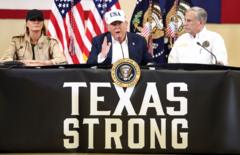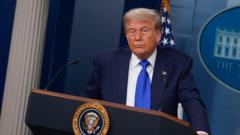Trump's announcement adds pressure on Canada as trade negotiations intensify, potentially impacting key industries dependent on U.S. markets.
Trump Unveils 35% Tariffs on Canadian Goods Amidst Trade Negotiations

Trump Unveils 35% Tariffs on Canadian Goods Amidst Trade Negotiations
U.S. President Donald Trump threatens a 35% tariff on Canadian goods effective August 1, escalating trade tensions as the two nations aim for a new agreement.
U.S. President Donald Trump has announced a potential imposition of a 35% tariff on Canadian goods starting August 1, deepening tensions between the two nations just days before a self-imposed deadline to negotiate a new trade deal. This announcement, conveyed in a letter to Prime Minister Mark Carney, echoes Trump's broader tariff strategy that includes threats of similar tariffs ranging from 15% to 20% on other global trade partners, with intentions to inform the European Union of new tariff rates soon.
The letter regarding Canadian tariffs is part of a series of over 20 communications Trump has issued this week to various trade partners, including countries such as Japan, South Korea, and Sri Lanka. Currently, the U.S. has implemented a 25% tariff on a selection of Canadian imports, leaving Canada grappling with the repercussions of Trump’s global tariffs on steel, aluminum, and autos.
Details surrounding the impact of the new tariffs on goods covered by the Canada-United States-Mexico Agreement (CUSMA) remain unclear. In addition to the latest tariffs, Trump has instituted extensive tariffs on aluminum and steel imports at 50% and on vehicles not manufactured in the U.S. at 25%. He also plans a 50% tariff on copper imports effective next month.
With approximately 75% of Canadian goods being exported to the U.S.—especially in the automotive and metals sectors—the impending tariffs pose significant threats to Canada’s economy. In his letter, Trump linked the tariffs to Canada's alleged failure to halt the flow of fentanyl into the U.S., as well as existing Canadian tariffs on U.S. dairy farmers and the ongoing trade deficit between the two nations.
“If Canada works with me to stop the flow of fentanyl, we will, perhaps, consider an adjustment to this letter,” Trump stated, indicating that tariff rates could vary depending on future relations. Data points to a minuscule amount of fentanyl reaching the U.S. via the Canadian border, primarily coming from Mexico instead.
In response to Trump’s concerns, Canada announced measures to bolster border security and appointed a fentanyl czar earlier this year. Ongoing discussions between Canada and the U.S. aim for a new trade and security deal, with a deadline set by the G7 Summit in June stipulating that an agreement should be achieved within 30 days—culminating on July 21.
Trump has warned of raised tariffs should Canada retaliate, while Canada has already imposed counter-tariffs. Recent compromises have been made to salvage negotiations, including Canada's decision to retract a tax on large U.S. technology firms, which previously drew Trump’s ire. No immediate comments were available from the Prime Minister's office following the publication of Trump's letter.


















